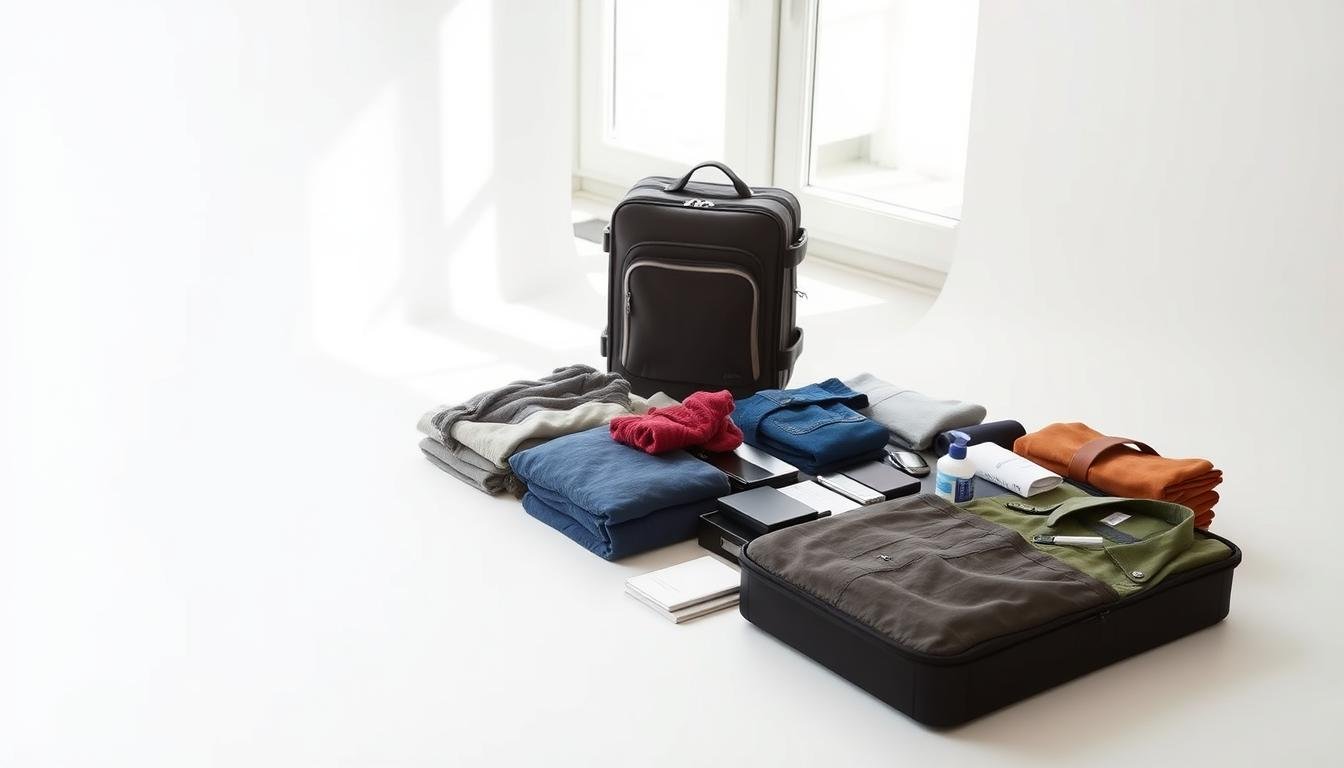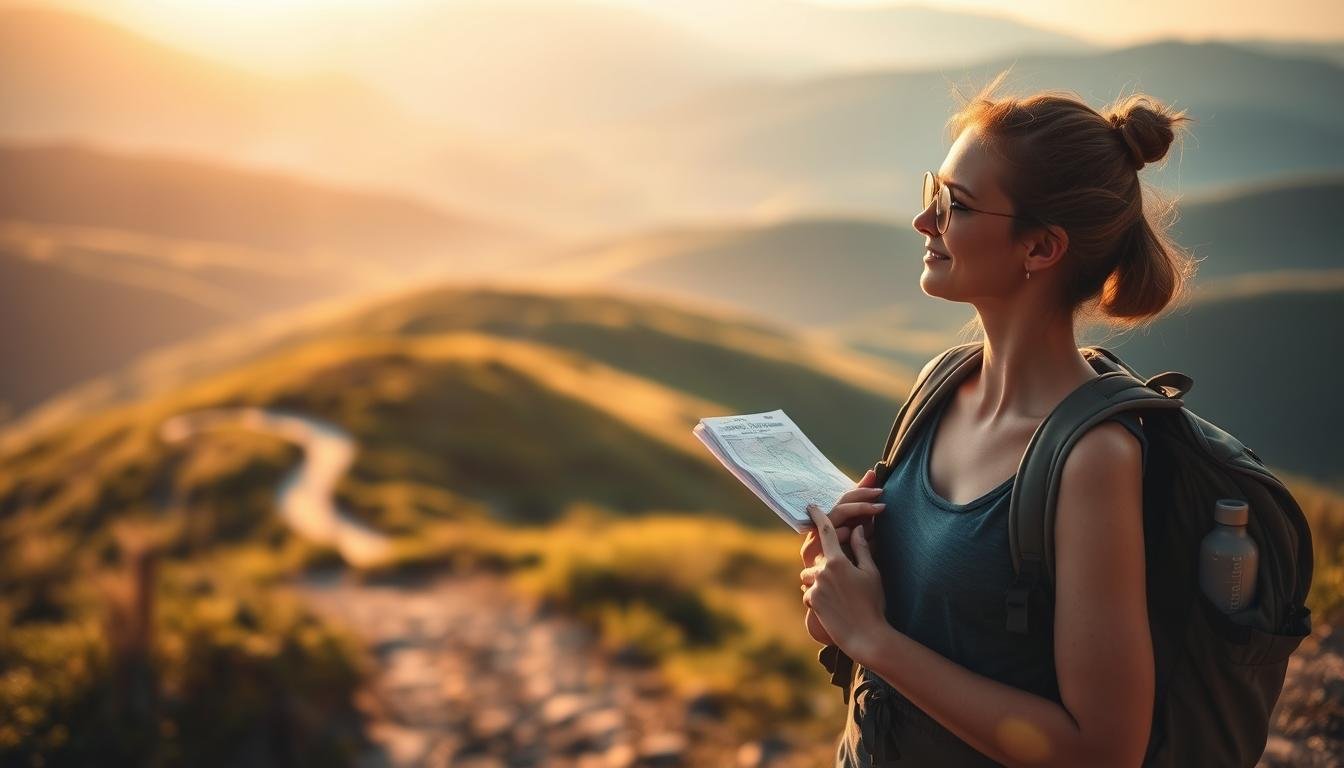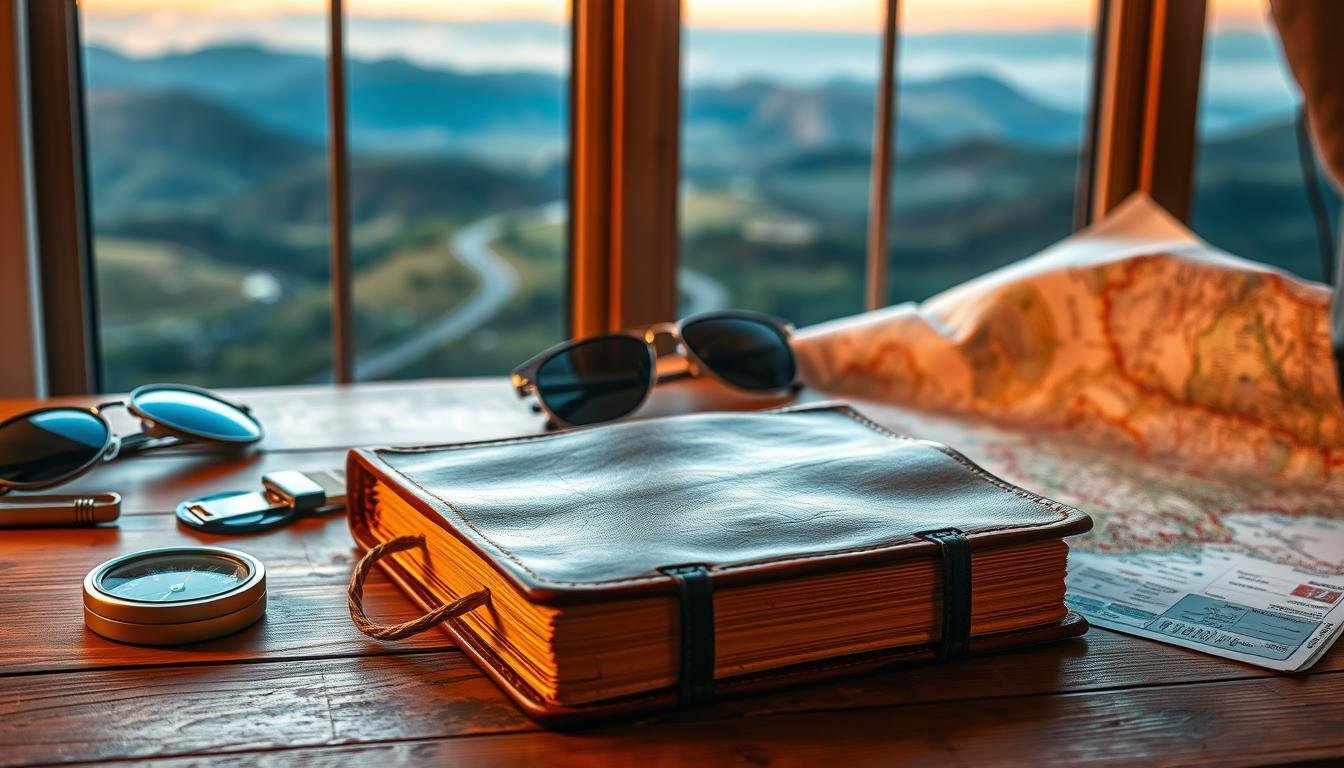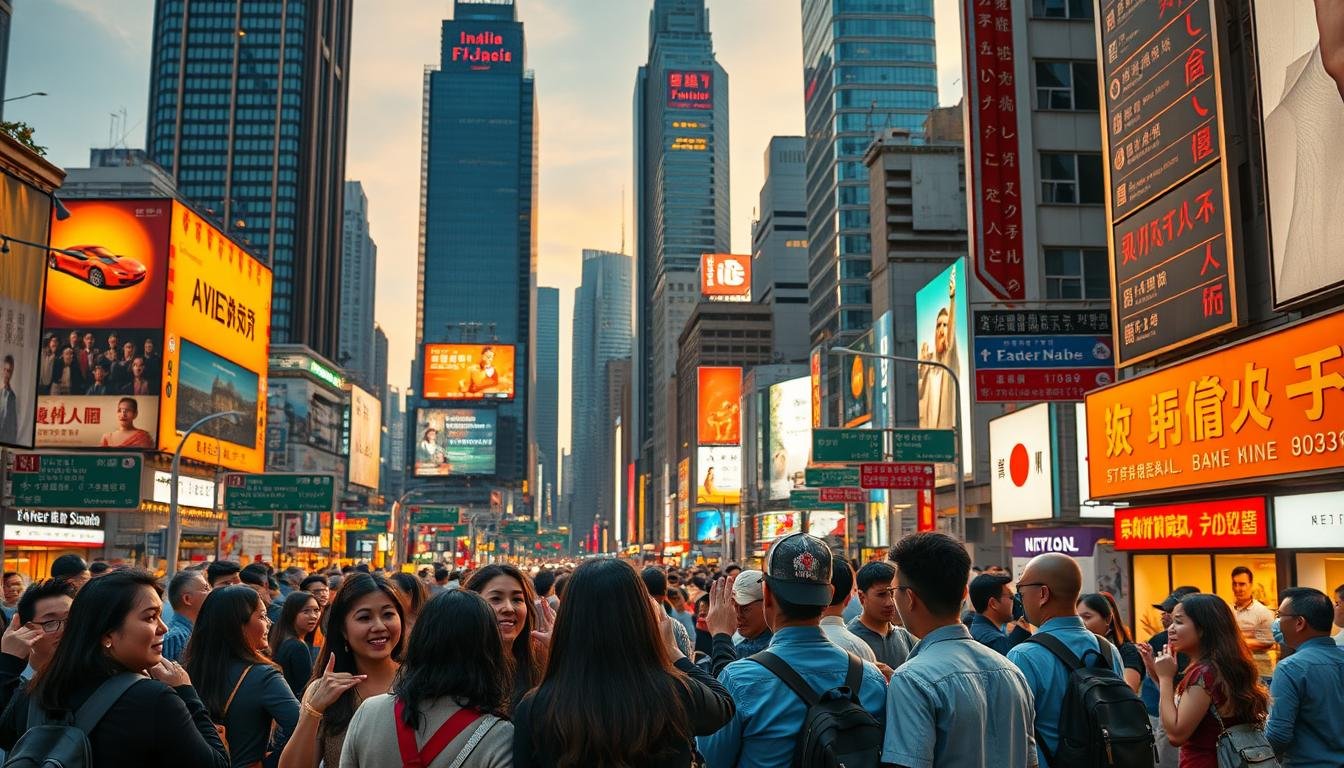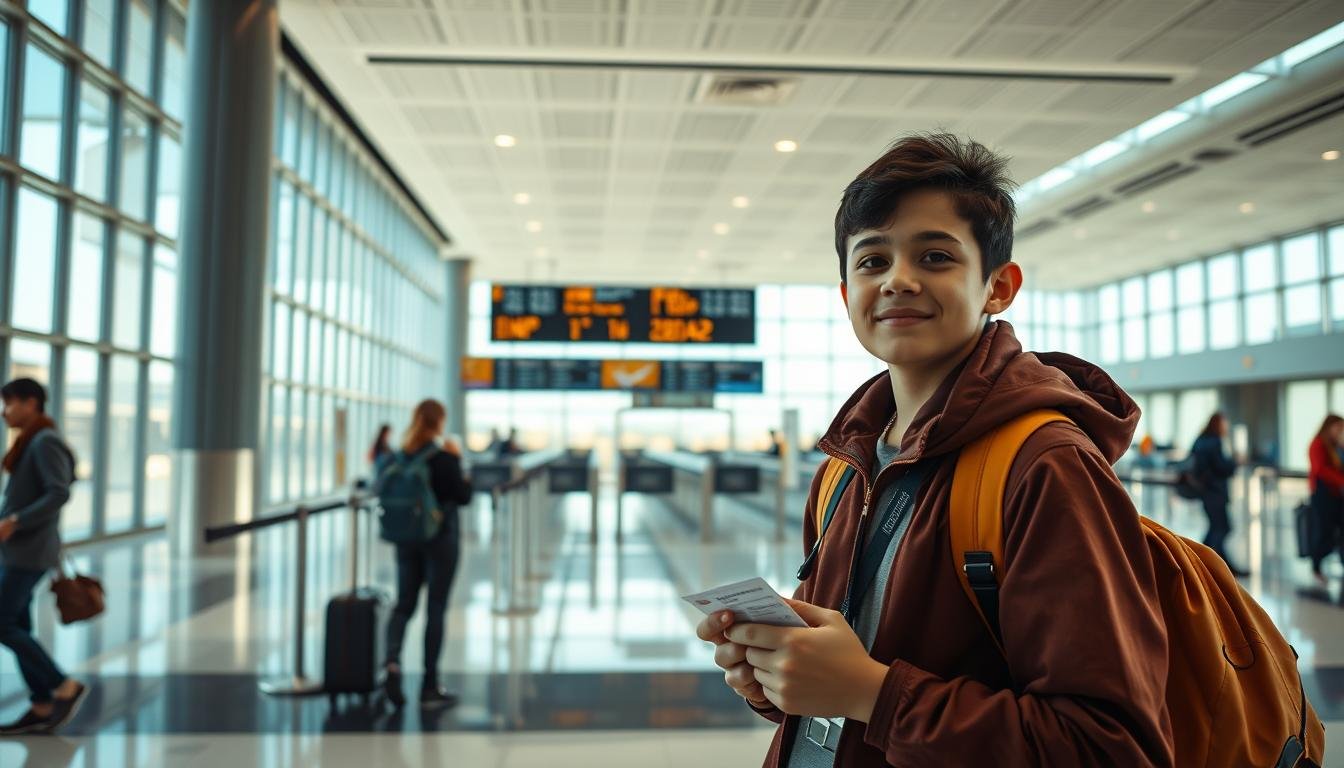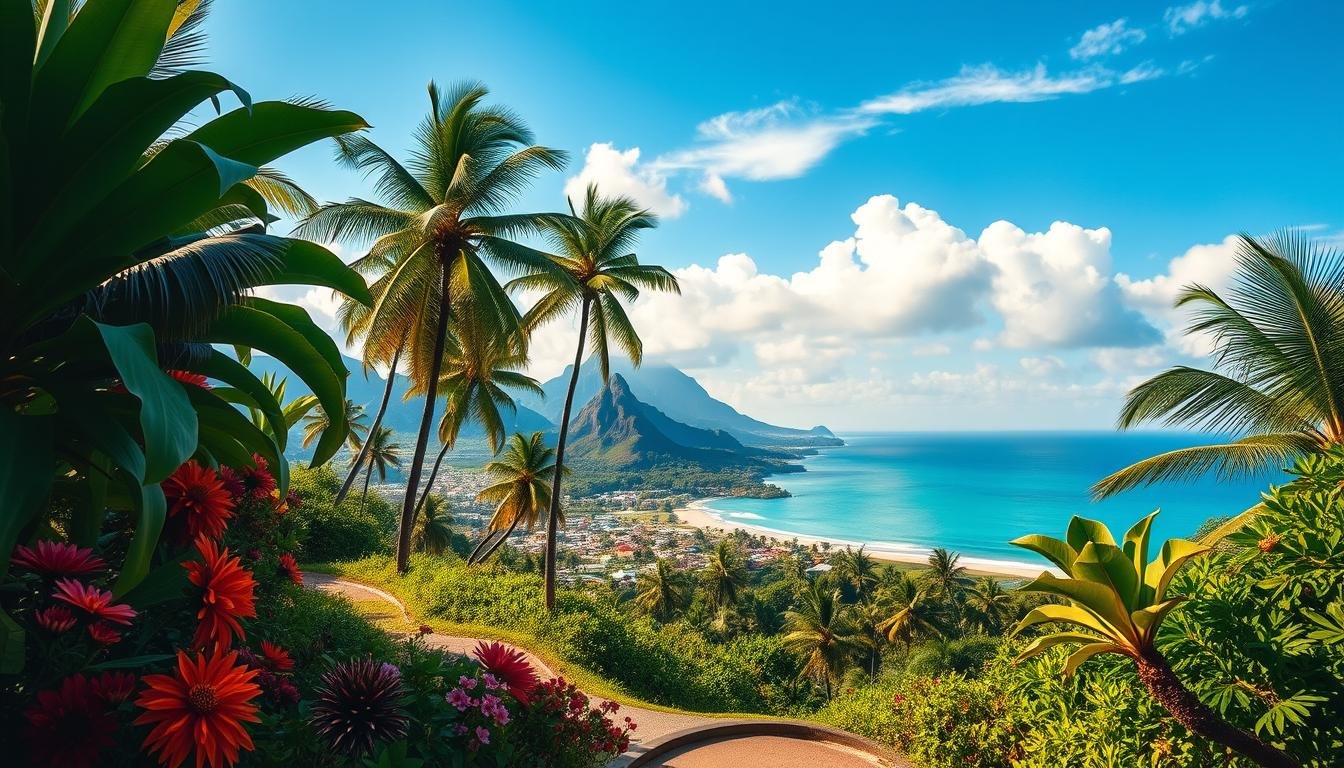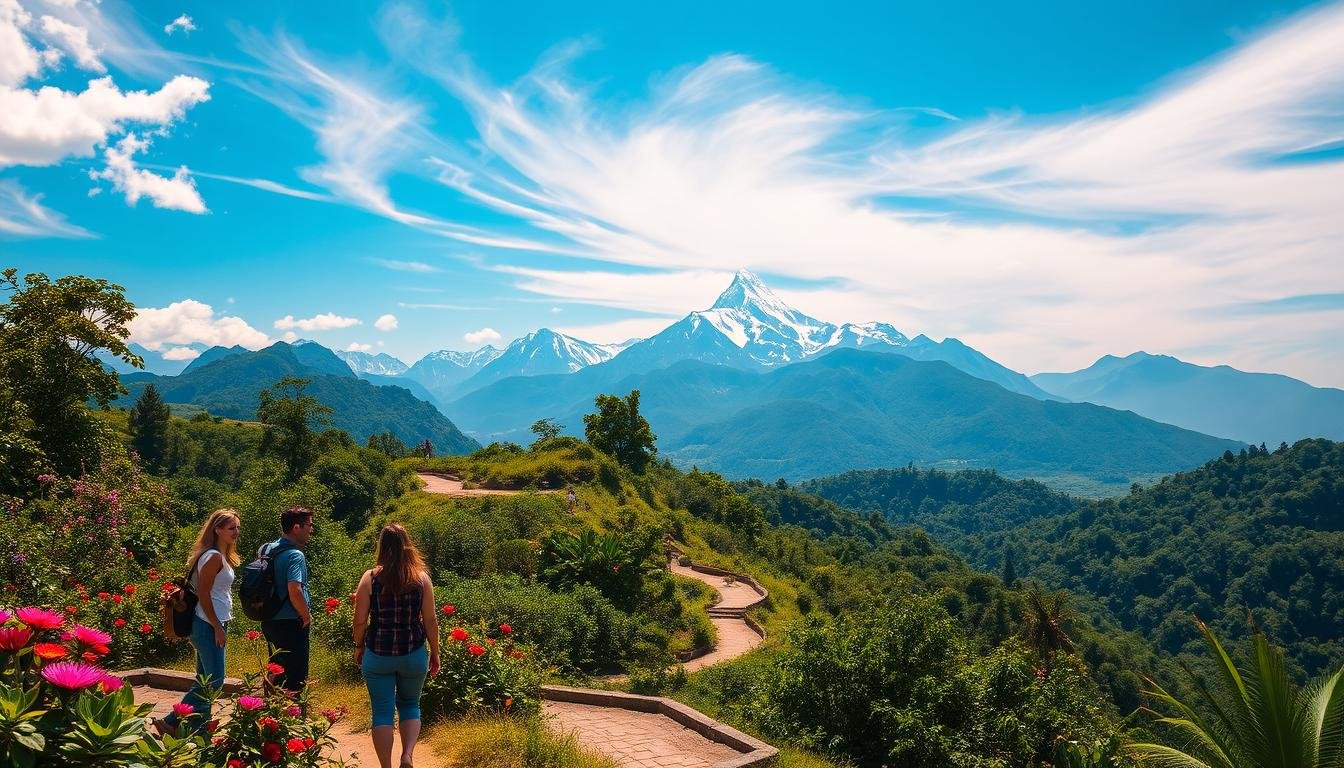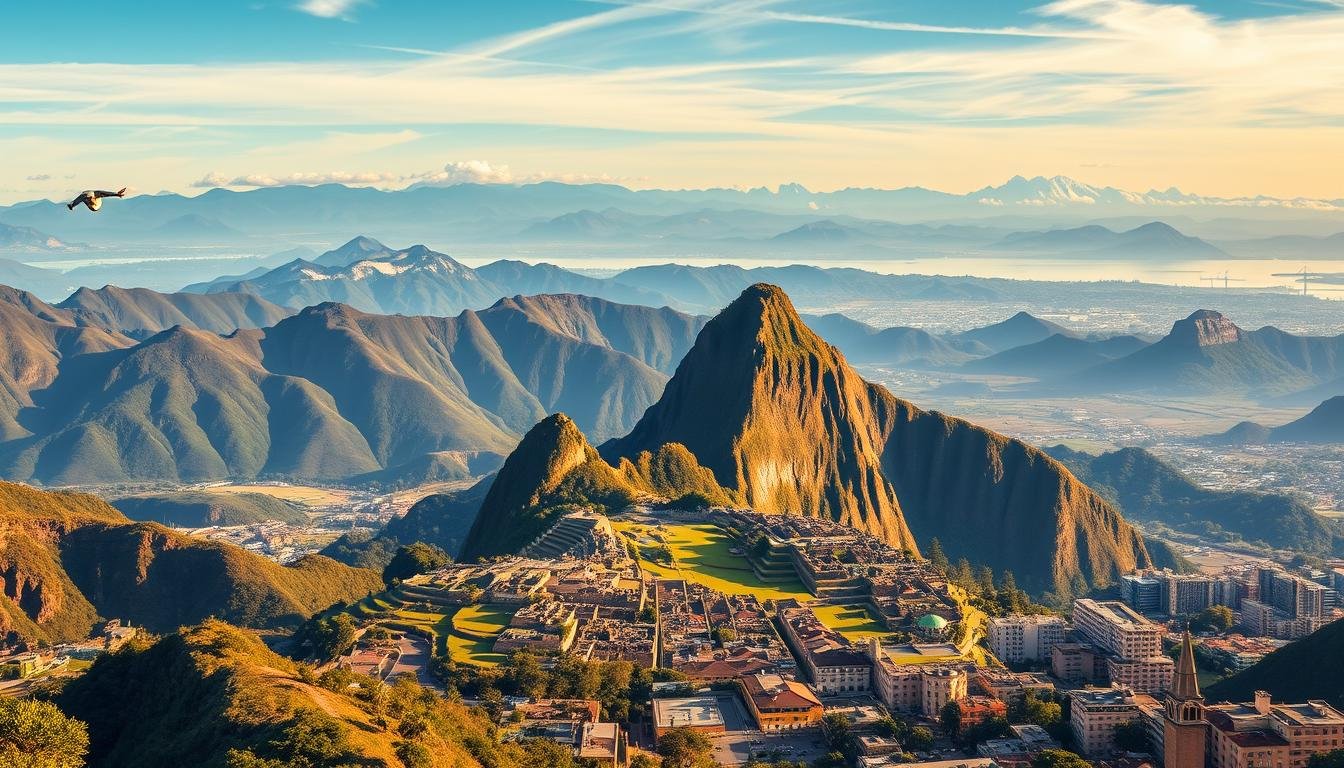As I get ready for my next international adventure, I think about packing efficiently. Traveling light makes a big difference. It lets us move easily and enjoy our trip without heavy bags.
With the right tips and gear, we can carry less and enjoy more. In this guide, I’ll share how to pack light for vacation. You’ll learn about choosing the best gear and carrying less.
Key Takeaways
- Understand the benefits of packing light for international travel
- Learn strategies for minimizing luggage
- Discover the importance of choosing the right gear
- Explore expert tips for efficient packing
- Maximize your travel experience with smart packing
The Benefits of Packing Light for International Adventures
Traveling light is more than a choice; it’s a key to a better travel experience. It reduces stress and boosts your ability to move around easily.
Freedom and Mobility While Traveling
Packing light makes it easy to get around airports and cities. You won’t be weighed down by heavy bags. This freedom lets you change your plans on a whim, perfect for exploring new places.
Cost Savings on Baggage Fees
Packing light can save you money on baggage fees. Airlines often charge extra for checked bags. Efficient packing for travel saves you cash and makes your trip smoother.
Reduced Physical Strain and Stress
Carrying heavy bags is hard on your body and stressful. Packing light eases this burden. It’s a big plus for long trips or when you’re visiting many places.
| Benefits | Description | Impact |
|---|---|---|
| Freedom and Mobility | Easy navigation through airports and cities | Increased flexibility in travel plans |
| Cost Savings | Avoidance of extra baggage fees | Financial savings on travel |
| Reduced Physical Strain | Less burden on the body during travel | More enjoyable travel experience |
Following minimalist packing tips leads to a more relaxed and efficient trip. Whether you’re a pro or new to international travel, packing light makes your journey better.
How to Pack Light for International Travel: The Fundamental Approach
To travel light, start by thinking about being flexible and efficient. This mindset is key for packing for an overseas trip without feeling weighed down by too much luggage.
The Minimalist Traveler Mindset
Traveling light is more than just packing less. It’s about being careful with what you choose to bring. It means understanding that carrying less gives you more freedom to enjoy your trip. Experienced travelers focus on the basics and cut out things they don’t need.
Assessing Your True Travel Needs
Before you pack, think about what you’ll do and where you’re going. Consider the weather and local customs. This helps you make a better and more useful travel essentials packing list.
The “Pack and Remove Half” Principle
A good way to pack light is the “pack and remove half” rule. Pack everything you think you’ll need, then cut that in half. This helps you focus on what’s really important and avoids packing too much. It’s a simple yet effective carry-on packing tip to keep you from overpacking.
Questions to Ask Before Packing Any Item
Before you add something to your bag, ask yourself:
- Do I really need this?
- Can I replace it if necessary?
- Does it serve more than one purpose?
By carefully thinking about each item, you can make your packing more efficient. This way, you only bring what’s truly essential.
Pre-Trip Planning: The Foundation of Light Packing
Packing light starts before you fly. Good pre-trip planning makes travel stress-free and fun. Spend time researching and preparing to avoid heavy luggage.
Researching Your Destination’s Climate and Cultural Norms
It’s key to know your destination’s weather and culture. This helps you pack right clothes and avoid mistakes. For example, knowing the weather lets you pick the best clothes. Also, understanding local dress codes helps you fit in and enjoy your trip more.
Creating a Customized Packing List
A personalized packing list is essential. Make a list of must-haves based on your research. Include versatile clothes, essential toiletries, and the right electronics.
Planning Your Travel Wardrobe
Planning your clothes ahead is a big help. Think about what you’ll do and what to wear for each activity.
Outfit Planning for Your Entire Trip
Plan outfits with a few key pieces. This way, you can make many outfits. It cuts down on luggage and travel stress.
Using these planning tips, you’ll get better at organized packing for travel. Your international trips will be smoother and more fun.
Selecting the Right Luggage for Minimalist Travel
Choosing the right luggage is key for minimalist travel. The right bag can make your trip easier, less stressful, and more enjoyable. It helps you move through airports and destinations smoothly.
Carry-On Bags vs. Checked Luggage
First, decide between a carry-on bag and checked luggage. Carry-on bags keep your stuff with you, saving on fees. Checked luggage is better for big trips or lots of items.
Lightweight Suitcase Options
If you like suitcases, go for lightweight ones. They should be tough yet light, ready for travel’s challenges.
Backpacks for the Ultimate Light Traveler
Backpacks are great for those who love to move freely. They’re perfect for city trips or outdoor fun.
The best luggage for minimalist travel is balanced. It should be small, light, and useful. With the right bag, your trip will be smoother and less stressful.
Essential Clothing Strategies for Extended Trips
For travelers on long trips, knowing how to pack clothes is key. A smart wardrobe can greatly improve your travel experience.
The Versatile Capsule Wardrobe Approach
Using a capsule wardrobe is a smart way to pack light. It means choosing a few essential items that can be worn in many ways. Look for pieces that can be dressed up or down.
Benefits of a Capsule Wardrobe:
- Reduces decision fatigue
- Minimizes luggage space
- Encourages creativity in outfit planning
Fabric Selection for Easy Care and Quick Drying
Choosing the right fabrics is important for easy care and quick drying. Go for materials like merino wool, polyester blends, or nylon. They are good at wicking moisture and lasting long.
Layering Techniques for Different Climates
Layering is a smart way to adjust to different weather. By packing light layers, you can change your outfit to fit the temperature and activity.
Color Coordination for Maximum Outfit Combinations
Choosing colors wisely helps you make more outfits with fewer pieces. Pick 3-4 core colors and you can mix and match to create many outfits.
| Color | Items | Outfit Combinations |
|---|---|---|
| Neutral (Black, White, Gray) | 5 | 10 |
| Earth Tones (Brown, Beige) | 3 | 6 |
| Accent Color (Blue, Red) | 2 | 4 |
By using these strategies, you can create a useful and efficient wardrobe for long trips. This way, you make the most of your packing space.
Toiletries and Personal Care: Minimizing Bulk
Traveling light doesn’t mean you have to skip personal hygiene. It’s about being smart with what you pack. When you’re getting ready for a trip, find a balance between what you need and how much you carry.
Travel-Sized and Multi-Purpose Products
Using travel-sized toiletries is a smart move. You can also pour your regular products into smaller containers. This saves space and meets airline rules on liquids. Choose multi-purpose products like shampoo-conditioner combos or face washes that clean and tone.
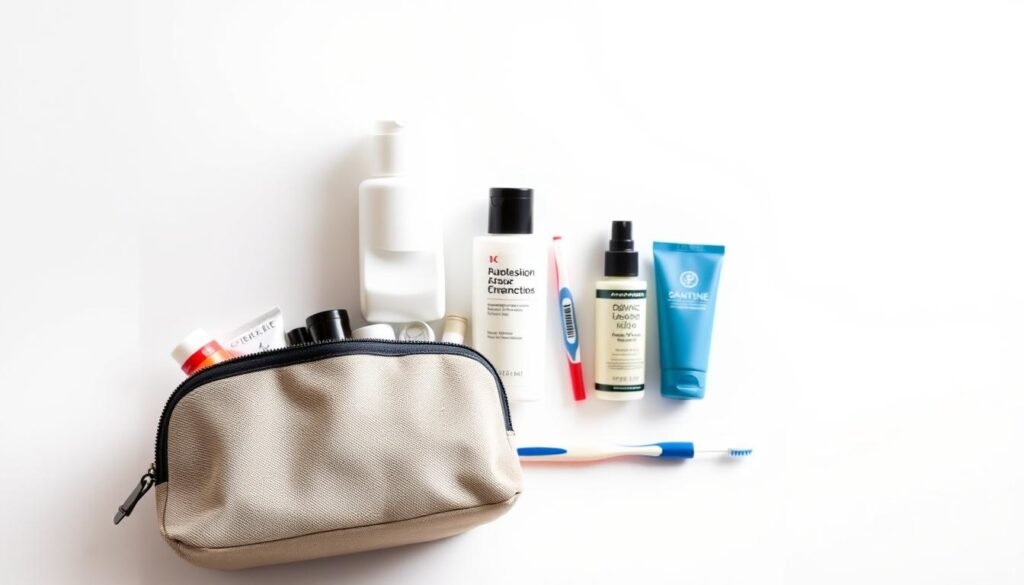
Solid Toiletries to Avoid Liquid Restrictions
Solid toiletries are great for travelers. Items like solid shampoo bars, toothpaste tablets, and deodorant sticks avoid liquid bans at security. They also last longer and are better for the environment.
What to Buy at Your Destination
Think about buying toiletries when you arrive. This is smart if you’re not sure what you’ll need or if local standards differ. It helps keep your luggage lighter.
Creating a Minimalist Toiletry Kit
To make a minimalist toiletry kit, list your must-haves. Pack only what you really need. Choose items that do more than one thing. Keep your toiletries in a clear, sealed bag for easy security checks. Being smart about your toiletries makes your trip easier and more enjoyable.
Tech and Electronics: What You Really Need
As a seasoned traveler, I’ve learned that the right tech can be a game-changer. Packing electronics for international travel is all about finding a balance. You want to be prepared without carrying too much.
Multipurpose Devices and Accessories
Choosing multipurpose devices is smart for packing less tech. A smartphone can be a camera, GPS, and even a wallet. A portable power bank, like the Anker PowerCore Fusion, is great for charging many devices at once. It saves space and keeps your devices charged.
Charging Solutions and International Adapters
Keeping your electronics charged is key when traveling. Know the power outlets in your destinations and get a universal travel adapter, like the REI Universal Travel Adapter. Also, pack a compact power bank for charging on the move.
Digital Alternatives to Physical Items
In today’s world, digital options can replace many physical items. E-books can replace books, and digital maps can replace paper ones. Use travel apps for real-time updates and info.
Protecting Your Tech While Traveling Light
To keep your tech safe, use a protective sleeve for laptops and tablets. A waterproof phone case adds extra protection. Always keep your devices close and be aware of your surroundings to avoid theft.
By carefully choosing the tech you pack and protecting it, you can have a smoother and less stressful trip.
- Choose multipurpose devices to minimize luggage space.
- Invest in a universal travel adapter for charging in different countries.
- Use digital alternatives to reduce physical items.
- Protect your tech with appropriate cases and sleeves.
Advanced Packing Techniques and Organization
As a seasoned traveler, I’ve learned that the key to a smooth journey lies in advanced packing techniques. Efficient packing is not just about throwing clothes and essentials into a suitcase; it’s an art that requires strategy and planning.
Rolling vs. Folding vs. Bundle Wrapping
Different packing methods can significantly impact the space and organization of your luggage. Rolling clothes is a popular technique that reduces wrinkles and saves space. Folding, on the other hand, is better for items like sweaters that are prone to stretching when rolled. Bundle wrapping is another method that involves wrapping clothes around a central object, creating a compact bundle.
Compression Methods and Packing Cubes
Compression bags and packing cubes are game-changers for travelers. They help in organizing your belongings and compressing your clothing to make the most of your luggage space. For more insights on efficient packing, you can visit this resource.
Strategic Placement for Weight Distribution
Proper weight distribution is key for comfortable handling of your luggage. Heavier items should be placed at the bottom of the suitcase, close to the wheels, to maintain balance.
Maximizing Every Inch of Space
To maximize space, consider using every available nook and cranny in your luggage. For instance, you can fill your shoes with socks or undergarments. Here’s a simple table to illustrate some space-saving strategies:
| Item | Space-Saving Tip |
|---|---|
| Socks | Fill shoes or gaps between clothes |
| Toiletries | Use travel-sized containers |
| Clothing | Roll or bundle wrap |
As travel expert,
“The key to successful packing is not just about what you pack, but how you pack it.”
This quote emphasizes the importance of technique in packing.
By implementing these advanced packing techniques, you can enjoy a more organized and stress-free travel experience.
Destination-Specific Packing Considerations
The key to efficient packing lies in understanding the specific needs of your travel destination.
Tropical and Beach Destinations
When heading to a tropical or beach destination, lightweight and breathable clothing is essential. Consider packing clothes that can be easily mixed and matched. Don’t forget a reliable sunscreen.
Cold Weather and Winter Travel
For cold weather destinations, layering is key. Pack thermal base layers, insulating mid-layers, and a waterproof outer layer. This will keep you warm and dry.
Urban Explorations vs. Outdoor Adventures
The type of activities you plan can significantly influence your packing list. For urban explorations, comfortable walking shoes and versatile clothing are key. For outdoor adventures, consider packing specialized gear relevant to your activities.
Adapting Your Packing Strategy by Trip Type
Understanding whether your trip is focused on culture, adventure, or relaxation helps in tailoring your packing list. For instance, a cultural tour might require more formal attire. While an adventure trip demands durable and functional clothing.
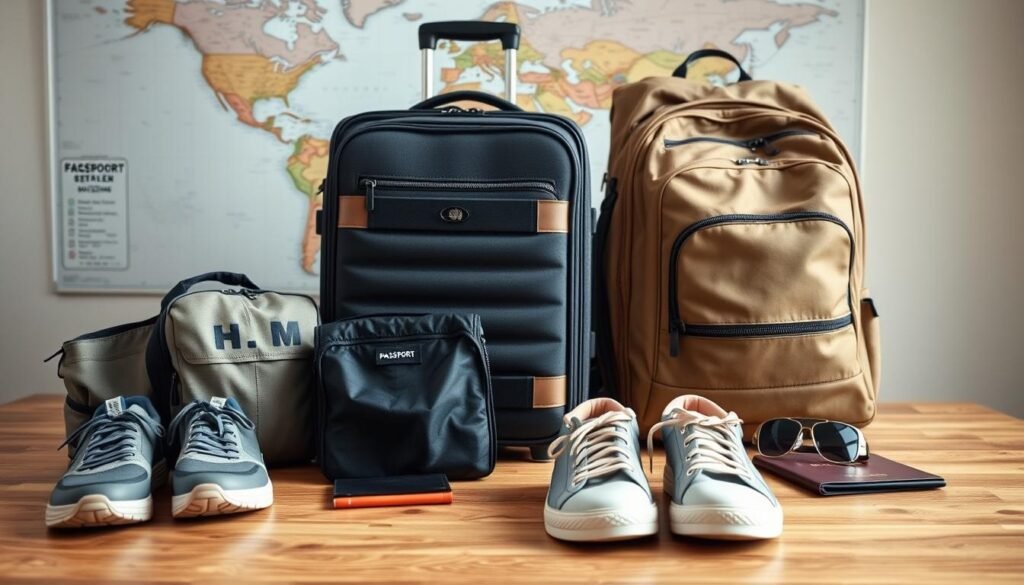
Navigating International Travel Regulations
Understanding international travel rules is key for a smooth trip. Before you go, learn about the rules for flying across borders.
TSA and International Security Requirements
The Transportation Security Administration (TSA) has strict rules for all travelers. Make sure your carry-on liquids are 3.4 ounces or less. Also, have your electronic devices ready for screening.
- Check the TSA’s website for the latest security rules.
- Know the 3-1-1 liquids rule to pass security checks easily.
Customs Considerations
It’s important to know the customs rules of your destination. Look into any item restrictions, like gifts or buys during your trip.
“Always declare all items you’re bringing, even if unsure about restrictions.” – U.S. Customs and Border Protection
Documentation Organization
Having the right documents is essential for travel. Make sure your passport is valid for at least six months after you leave. Also, make copies of important documents like your passport and visa (if needed).
Digital Copies and Emergency Preparedness
Scan your documents and save them online or email them to yourself. This way, you can quickly get to your documents in an emergency.
My Personal Packing List for a Two-Week International Trip
I’ve learned to pack light for any two-week trip abroad. It’s all about finding the right balance. You want to be ready for anything without carrying too much.
Clothing and Footwear Selection
I focus on clothes that can be worn in different ways. For a two-week trip, I bring:
- 3 tops that can be mixed and matched
- 2 pairs of pants or trousers
- 1 lightweight dress or jumpsuit
- 1 warm layer for cooler evenings
- Undergarments and socks
- Comfortable walking shoes
- Sandals or flip-flops
I pick items that can be dressed up or down. They should also fit the weather of my destination.
Toiletries and Personal Items
To save space, I choose travel-sized toiletries. I also use multi-purpose products and solid items when I can.
- Travel-sized toiletries
- Multi-purpose products
- Solid toiletries where possible
I also pack a first-aid kit, my medications, and a travel adapter. These are essentials.
Electronics and Miscellaneous Essentials
My electronics include:
- A smartphone with a universal power adapter
- A portable charger
- A laptop if necessary
I also bring a travel wallet, tissues, and earplugs. These add to my comfort.
How I Adapt My List for Different Destinations
I adjust my packing list for each destination. For warm places, I bring more swimwear and light clothes. For cold places, I add warm layers.
Knowing the local culture and weather helps me pack right. It makes my trip more enjoyable.
Conclusion: Embracing the Freedom of Traveling Light
Thinking about packing light for international travel reminds me of its many benefits. It’s not just about saving money on baggage fees. It’s about living a life that values freedom and being able to move easily. By packing lightly, you can avoid physical strain and stress, letting you enjoy your journey more.
Packing light has many advantages. It saves you money on baggage fees and makes moving through airports and cities easier. With less to carry, you can explore more, take unexpected turns, and have a more real travel experience.
When you start your next international trip, remember what we’ve talked about. By packing smart and light, you’ll enjoy more freedom and less stress. So, pack wisely, travel lightly, and find the happiness in exploring without being weighed down.
